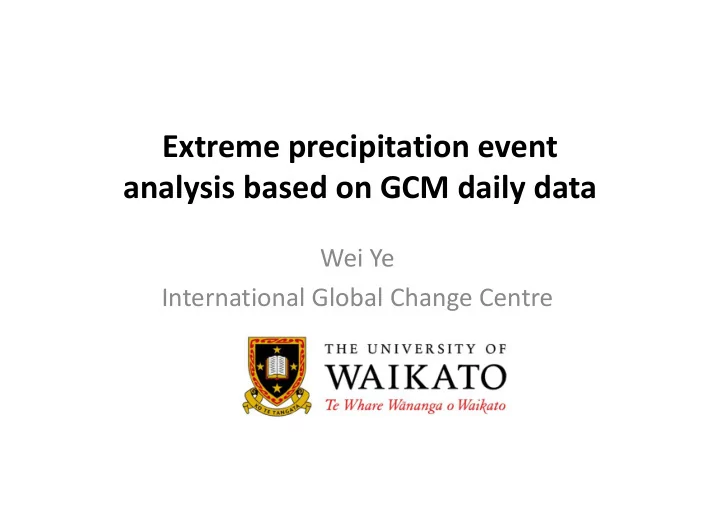

Extreme precipitation event analysis based on GCM daily data Wei Ye International Global Change Centre
Introduction • Extreme weather events such as heavy rainfall can be serious treat agriculture production, infrastructure and people’s life; • They have not been adequately appreciated or addressed in many studies of the impacts of climate change; • Precipitation is generally not as well simulated as air temperature in global climate models.
Introduction • Globally for each 1°C of surface warming, atmospheric precipitable water increase by ~9% and daily precipitation intensity increase by ~2%, whereas daily precipitation frequency decreases by 0.7%. • There is a tendency for an increase in daily heavy rainfall events in many regions, including some in which the mean rainfall is projected to decrease
Introduction • GCM is still the most reliable method in generating the future climate; • GCM results have been improving; • Daily simulation results from GCMs has became publically available since IPCC AR4.
Method and data • Very extreme precipitation events are well described by the statistical formalism of the Generalized Extreme Value (GEV) theory • Pattern scaling approach to generate normalized future change patterns.
Method and data • Observed data • GCM daily simulation data Daily results from 12 GCMs, 3 SRES scenarios (A1B, A2, and B1) and 2 sample periods (2046 ‐ 2065 and 2081 ‐ 2100). The period of 1981 ‐ 2000 was used to represent the baseline condition as suggested by IPCC AR4 (IPCC 2007).
Method and data Two fundamental assumptions for applying pattern scaling to climate change impact on extreme rainfall event analysis: • extreme rainfall events changes are linear to radiative forcing changes due to climate change • while the magnitude of extreme event value changes alter over time in proportion to the global warming, the pattern of change from the GCM remains constant
Method and data For a given GCM: • calculate a GEV function for baseline (Gb); • calculate GEV functions for future periods (Gf[i],i=1..6); • calculate extreme value from Gb and Gf[i], (RP20b, RP20f[i]); • calculate the differences between future and baseline (dRP20[i],i=1..6); • calculate global annual mean temperature change for the GCM, ( Δ��� (i),i=1..6); • calculate normalised change value from dRP20(i) and Δ���� i],(RP20P);
Method and data The 20 year return daily extreme rainfall changes for Australia normalised as per degree global warming (%/°C). Values are the median of the 12 GCM ensemble.
Method • 1) Build a GEV distribution from historical daily data and calculate its 20 RP value; • 2) Obtain the change pattern value from the spatial display build from above; • 3) Obtain the global average mean temperature change, which is determined by selecting a future year, GHG emission option and climate sensitivity; • 4) Calculate the change value based on 2) and 3) and add to 1) to obtain the future 20 RP value for the selected climate change scenario.
Application and result Location of the rainfall stations (Selected from 152 High ‐ quality Australian daily rainfall dataset. (Lavery et al. 1992).
Application and result
Application and result
Application and result
Application and result Extreme events 5 10 20 50 100 Station Name Change Change Change Change Change 1990 2080 2080 2080 2080 2080 1990 1990 1990 1990 (%) (%) (%) (%) (%) Ej 52.19 62.73 20.20 65.71 79.44 20.89 80.10 97.64 21.90 101.04 124.81 23.52 118.64 148.24 24.95 LC 49.05 59.10 20.49 61.33 74.45 21.39 73.86 90.62 22.69 91.23 113.87 24.81 105.16 133.19 26.65 Op 124.01 142.66 15.04 150.30 174.93 16.39 178.98 208.98 16.76 221.91 258.04 16.28 258.99 298.88 15.40 Mr 46.10 55.10 19.52 61.45 72.52 18.01 79.90 94.38 18.12 110.72 132.74 19.89 140.32 171.40 22.15 Ap 45.23 53.35 17.95 54.81 64.78 18.19 64.44 76.61 18.89 77.54 93.29 20.31 87.86 106.89 21.65 Ph 116.44 133.38 14.55 138.34 158.76 14.76 160.58 185.84 15.73 191.26 225.33 17.81 215.74 258.62 19.88 FSM 174.51 208.83 19.67 214.53 257.01 19.80 250.88 300.44 19.75 295.14 352.89 19.57 326.36 389.58 19.37 CML 142.07 172.27 21.26 168.12 204.80 21.82 193.59 237.60 22.73 227.30 282.48 24.28 253.10 318.01 25.65 PHPO 73.53 88.86 20.85 87.98 106.86 21.46 102.45 125.36 22.36 122.08 151.26 23.90 137.51 172.22 25.24 WPL 62.06 74.69 20.35 72.06 86.17 19.58 81.96 97.95 19.51 95.23 114.40 20.13 105.54 127.68 20.98 Sr 57.96 70.59 21.79 71.01 86.41 21.69 84.16 102.67 21.99 102.13 125.40 22.78 116.34 143.77 23.58
Application and result Baseline RPI of Extreme events 5 10 20 50 100 Station Name 2080 Change (%) 2080 Change (%) 2080 Change (%) 2080 Change (%) 2080 Change (%) Ej 3.17 36.60 5.68 4320 10.27 48.65 22.60 54.80 41.07 58.93 LC 3.16 36.80 5.54 44.60 9.74 51.30 20.51 58.98 35.87 64.13 Op 3.33 33.40 5.90 10.88 45.60 25.70 48.60 50.85 49.15 41.00 Mr 3.28 6.55 34.50 12.88 35.60 30.66 38.68 58.11 41.89 34.40 Ap 3.07 38.60 5.47 45.30 9.80 51.00 21.09 57.82 37.40 62.60 Ph 3.12 37.60 5.74 42.60 10.49 47.55 22.83 54.34 40.42 59.98 FSM 3.23 35.40 5.40 46.00 9.11 54.45 18.32 63.36 31.12 68.88 CML 2.69 46.20 4.58 54.20 7.87 60.65 16.12 67.76 27.58 72.42 PHPO 2.80 44.00 4.83 51.70 8.45 57.75 17.73 64.54 31.00 69.00 WPL 2.39 52.20 4.27 57.30 7.76 61.20 17.09 65.82 30.77 69.23 Sr 2.90 42.00 5.09 49.20 9.07 54.65 19.56 60.88 34.98 65.02
Conclusion and future development • The results are generally in accord with the hypothesis that the hydrologic cycle should intensify and become highly volatile with the greenhouse ‐ gas ‐ induced climate change, which is also supported by the up ‐ to ‐ date observations • The method would benefit greatly if longer time daily GCM simulation results become available • No downscaling method involved in this method. Daily GCM precipitation outputs were analyzed in their original spatial resolution in order to retain the extreme precipitation change trend of GCMs.
Recommend
More recommend